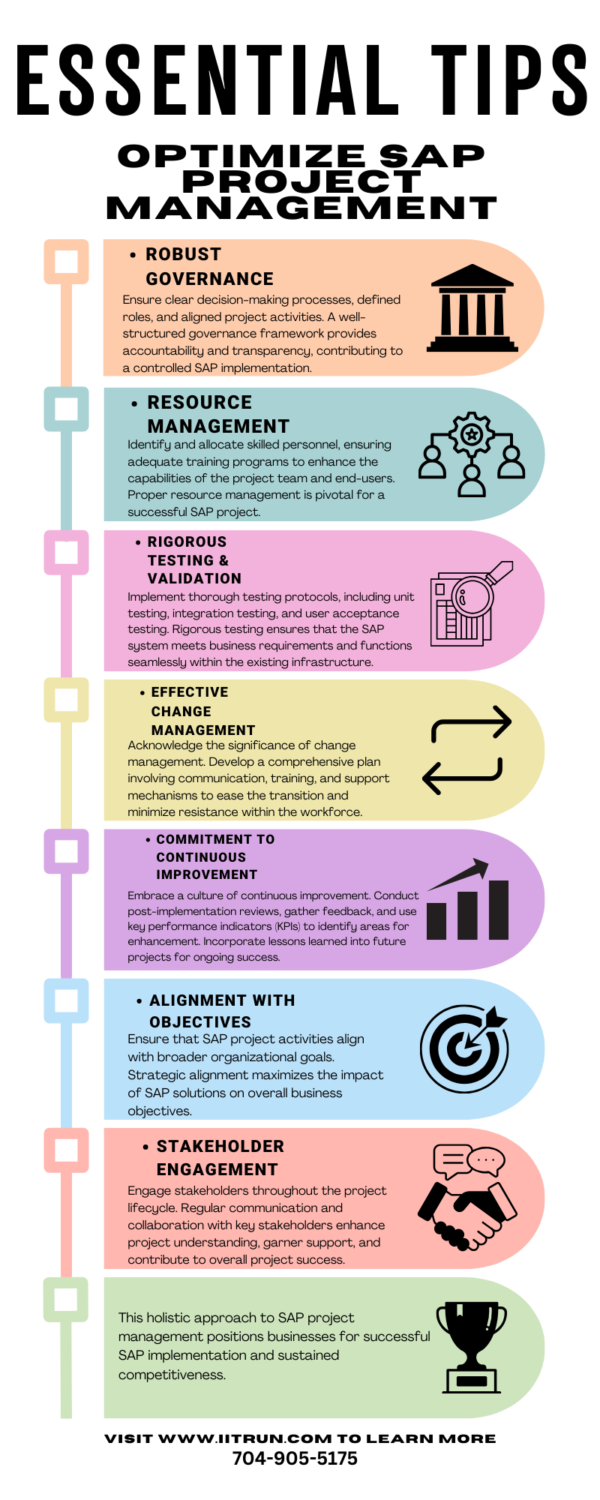 SAP, with its transformative capabilities, holds the potential to reshape how businesses operate. Yet, the path to successful SAP integration is a complex one, demanding not just technical expertise but a robust project management strategy. Otherwise, you risk problems such as blown timelines and budgets, poor communication, and an overall subpar implementation.
SAP, with its transformative capabilities, holds the potential to reshape how businesses operate. Yet, the path to successful SAP integration is a complex one, demanding not just technical expertise but a robust project management strategy. Otherwise, you risk problems such as blown timelines and budgets, poor communication, and an overall subpar implementation.
 Defining the Foundation: Clear Objectives and Structured Plans
Defining the Foundation: Clear Objectives and Structured Plans
Embarking on a successful SAP project requires laying a solid foundation built upon clear objectives and meticulously structured plans. At the outset, the team must gain a comprehensive understanding of the business objectives driving the project forward. These objectives serve as a guide, ensuring that every aspect of the SAP implementation aligns seamlessly with the overarching goals of the organization.
To start, the team needs to define the scope of the project. To do so, the team needs to delineate the boundaries of what the SAP system will encompass, outlining the specific functionalities, modules, and processes that will be included. By establishing a clear scope, stakeholders can avoid scope creep (read this article to learn more) and ensure that the project stays focused on delivering tangible value to the business.
Once the scope is defined, the business needs to set SMART (Specific, Measurable, Achievable, Relevant, Time-bound) goals that delineate the desired outcomes of the project. These goals provide a clear roadmap for success, allowing stakeholders to track progress, measure performance, and celebrate milestones along the way.
With the objectives in place, the next critical step is to develop a well-structured project plan that serves as the roadmap for the entire SAP implementation journey. This plan should encompass detailed timelines, outlining key milestones and deliverables at each stage of the project. Additionally, it should allocate resources effectively, ensuring that the right people with the necessary skills are assigned to the appropriate tasks.
The team also needs to integrate risk mitigation strategies, identifying potential risks and outlining proactive measures to address them. By anticipating challenges and having contingency plans in place, project teams can navigate unforeseen obstacles with confidence, minimizing disruptions and delays.
In essence, defining clear objectives and structured plans lays the groundwork for a successful SAP implementation, providing the guiding framework that empowers project teams to execute with precision and achieve transformative outcomes for the organization.
 Communication: The Cornerstone of Collaboration
Communication: The Cornerstone of Collaboration
The team must facilitate seamless collaboration, where the complexity of tasks and involvement of diverse stakeholders require a harmonized approach. To successfully execute a project, the team needs to establish transparent and open lines of communication.
In the multifaceted landscape of SAP projects, effective communication is more than a tool – it’s the lifeline that binds different departments and stakeholders together. Clear and consistent communication channels ensure that every team member is on the same page regarding project objectives, tasks, and expectations.
Additionally, regular updates play a pivotal role in keeping all stakeholders informed about the project’s progress. Whether the team is sharing achievements, addressing challenges, or highlighting upcoming milestones, these updates foster a sense of collective ownership and engagement among team members. This transparency not only builds trust, but also allows for timely identification and resolution of issues, preventing potential roadblocks from derailing the project.
Finally, the team must create an environment where feedback is encouraged. Open lines of communication should extend to a culture that values input from all team members. By actively seeking and incorporating feedback, project teams can tap into the collective expertise of individuals, fostering innovation and continuous improvement throughout the SAP implementation journey.
The collaborative nature of SAP implementations often involves numerous departments working in tandem. From IT and finance to operations and human resources, each department brings its unique perspective and requirements to the table. Effective communication becomes the glue that binds these diverse elements, ensuring that everyone is aligned towards the common goal of a successful SAP project.
 Navigating Risks and Embracing Flexibility
Navigating Risks and Embracing Flexibility
Embarking on SAP projects introduces a dynamic landscape with inherent risks due to their scale and intricacy. Crafting a robust project management strategy becomes paramount, encompassing comprehensive risk management practices to navigate these challenges effectively.
The first step in mitigating risks is a thorough identification process. Recognizing potential challenges and uncertainties that may arise during the course of the project lays the groundwork for proactive risk management. This involves evaluating each risk’s likelihood, impact, and potential consequences on the project’s timeline and objectives.
Once the team identifies any risks, the next crucial step is assessment. Understanding the magnitude of each risk allows project managers to prioritize and allocate resources efficiently. This evaluative phase helps determine which risks pose the most significant threats and require immediate attention. It also aids in developing a nuanced understanding of the interconnectedness of risks within the SAP project ecosystem.
After identification and assessment, the team should set mitigation plans to shield against potential roadblocks. Addressing risks before they escalate is pivotal for ensuring the project’s smooth progression. These plans outline specific actions, responsibilities, and timelines for tackling identified risks. Whether through contingency measures, resource reallocation, or strategic adjustments, a proactive approach minimizes the impact of risks on the project’s trajectory.
Additionally, flexibility emerges as a critical component in the risk management arsenal. The dynamic nature of business and technology demands adaptability to evolving circumstances. A flexible project management approach accommodates unforeseen challenges and changes, allowing for swift adjustments without deviating from the overarching project objectives.
 Continuous Monitoring and Evaluation
Continuous Monitoring and Evaluation
The journey of an SAP project doesn’t conclude with its initiation; instead, it unfolds as a dynamic process that demands continuous monitoring and evaluation. This ongoing vigilance is integral to ensuring that the project remains aligned with its predefined benchmarks and – more importantly – with the overarching business goals.
Regular assessments serve as the compass that guides the project team. By comparing progress against predefined benchmarks, project managers gain insights into the project’s performance. This vigilant tracking not only identifies areas where the project excels, but also pinpoints potential areas for improvement.
However, these assessments are not only checkpoints. Rather, they should be catalysts for continuous refinement. After all, the iterative nature of the monitoring and evaluation process allows project teams to adapt and enhance their strategies. Insights gained from regular assessments become the building blocks for refining project approaches, optimizing resource allocation, and fine-tuning execution methodologies.
Incorporating continuous improvement into the project ensures that the journey isn’t just a series of predefined steps, but a dynamic and adaptive process. Each iteration brings the project closer to its goals by addressing challenges, leveraging successes, and aligning with evolving business requirements. This cyclical approach transforms SAP projects into living entities that evolve, adapt, and ultimately thrive in the ever-changing landscape of business and technology.
 Governance and Resource Management
Governance and Resource Management
Effective governance acts as the guiding compass that navigates SAP projects through the intricacies of implementation. When the team establishes a robust governance structure, they create a roadmap that not only outlines the project’s trajectory, but also ensures clarity in decision-making processes. With a well-defined governance framework, roles and responsibilities are clearly delineated, aligning every team member with their specific contributions to the project’s success.
A key facet of effective governance is the establishment of clear decision-making processes. By defining how decisions will be made, who holds decision-making authority, and how information flows within the project, organizations ensure that their SAP implementation stays on course. This clarity in decision-making helps prevent delays, misunderstandings, and conflicts, fostering an environment of efficiency and accountability.
Roles and responsibilities form the backbone of any successful SAP project. A robust governance structure outlines the specific responsibilities of each team member, ensuring that everyone understands their role in contributing to the project’s objectives. This clarity minimizes ambiguity, enhances collaboration, and streamlines communication within the project team.
Moreover, effective governance allows the team to align project activities with organizational objectives. By ensuring that every decision, action, and milestone aligns with broader business goals, organizations can leverage SAP implementation as a strategic tool for overall organizational success.
Resource management is another pivotal consideration in SAP project management. Teams that identify and allocate the right personnel with the necessary skills and expertise ensure project success. To create a well-structured resource management plan, the team needs to assess the skills required for each phase of the project and strategically assign individuals with complementary expertise.
In addition to identifying the right talent, organizations must consider the importance of adequate training programs. The dynamic nature of SAP projects demands a workforce that is not only skilled but also adaptable. Training programs play a crucial role in enhancing the capabilities of both the project team and end-users, ensuring a seamless transition to the new SAP environment.
 Testing, Change Management, and Continuous Improvement
Testing, Change Management, and Continuous Improvement
Testing and validation stand as pillars of assurance throughout the entire lifecycle of an SAP project. These processes play a pivotal role in ensuring the seamless functioning of the SAP system and preventing issues from impacting the live environment. In particular, rigorous testing protocols encompass various stages, including unit testing, integration testing, and user acceptance testing. Each phase aims to identify and rectify potential issues, ensuring that the SAP system aligns with business requirements and functions seamlessly.
Change management, often underestimated, holds immense significance in the context of SAP projects. As organizations transition to new SAP solutions, a well-structured change management plan becomes vital for success. This plan involves clear communication strategies, comprehensive training programs, and robust support mechanisms. By addressing potential resistance within the workforce, organizations can ease the transition, ensuring that employees adapt smoothly to changes in workflows and processes.
As Smith’s contribution to SAPMint indicates, teams that want to effectively manage the scope of an SAP project with change management need clearly defined change control procedures.1 In particular, these procedures need to specify how the team should prioritize, document, evaluate, submit, and approve any changes.
Change impact assessment holds a pivotal role in this framework, involving the comprehensive evaluation of potential effects on various aspects such as expenses, time, and overall feasibility. A diligent evaluation empowers project managers to make informed decisions, ensuring that approved changes align seamlessly with the overarching goals of the project.
Following the evaluation and approval of change requests, clear and timely communication becomes paramount. For instance, the team needs to notify stakeholders about approved changes and update project documentation.
Continuous improvement is not just a philosophy but a practical approach in SAP project management. Post-implementation reviews, feedback mechanisms, and key performance indicators (KPIs) serve as tools for evaluating the success of the SAP project. These assessments help identify areas for improvement and provide valuable insights for future projects. Incorporating lessons learned into subsequent initiatives contributes to the organization’s overall growth and maturity in handling SAP initiatives.
In essence, the synergy of rigorous testing, effective change management, and a commitment to continuous improvement forms the cornerstone of successful SAP project management. By adopting these practices, organizations can navigate the complexities of SAP implementations, mitigate risks, and position themselves for sustained success in the dynamic landscape of business and technology.
A Holistic Approach for Sustained Competitiveness
Businesses leveraging SAP solutions should approach project management holistically. By integrating governance, resource management, thorough testing, change management, and a commitment to continuous improvement into their SAP project strategy, organizations can enhance the likelihood of successful implementation. This not only unlocks the full benefits of SAP solutions, but also positions businesses for sustained competitiveness in the dynamic business landscape. Embrace the art of quality project management, and let SAP propel your business to new heights.

1 In Control and On Target: How to Efficiently Manage SAP Project Scope (sapmint.com)






Leave A Comment